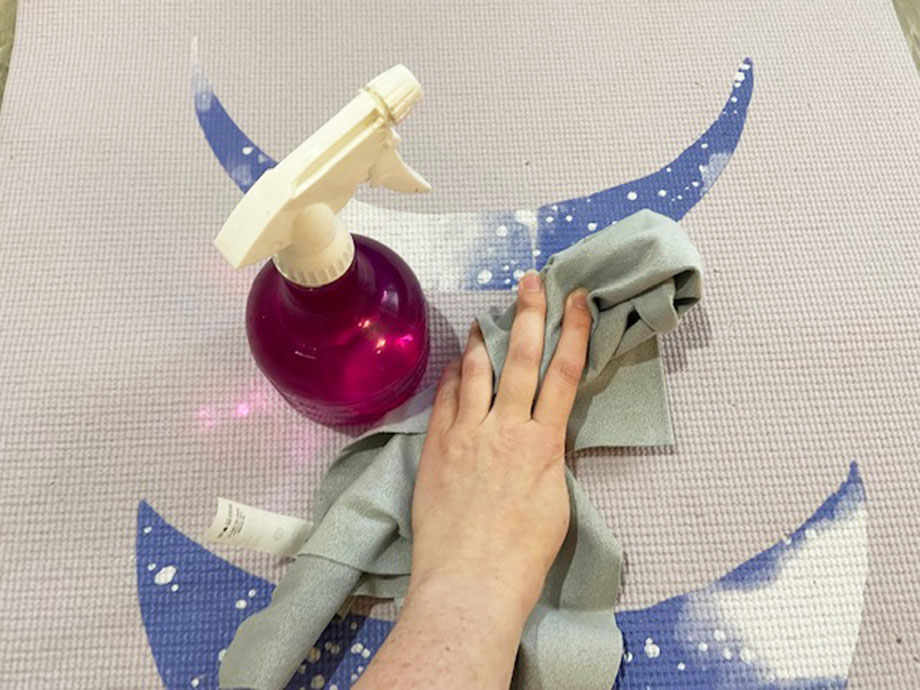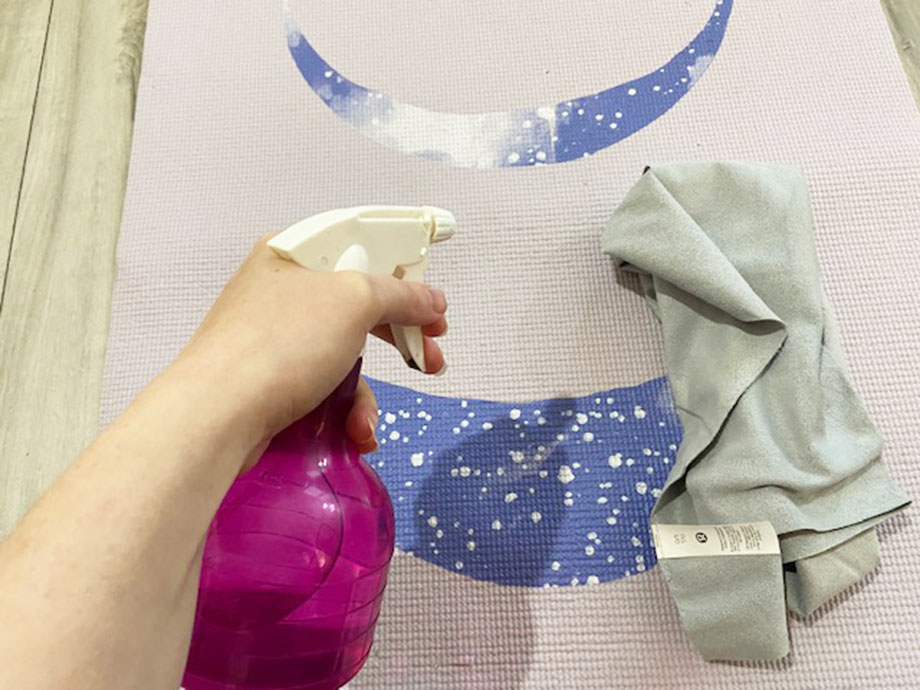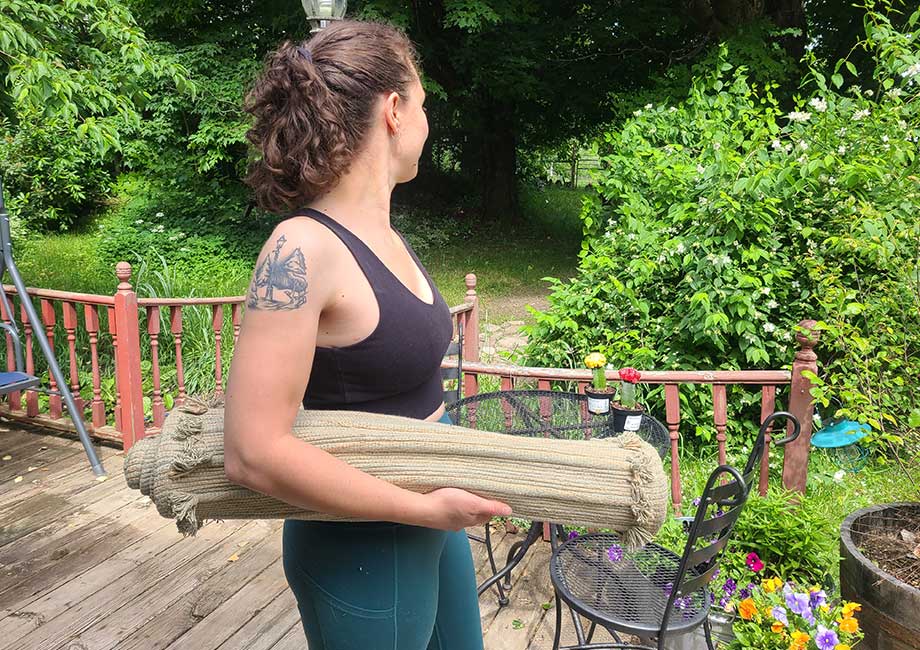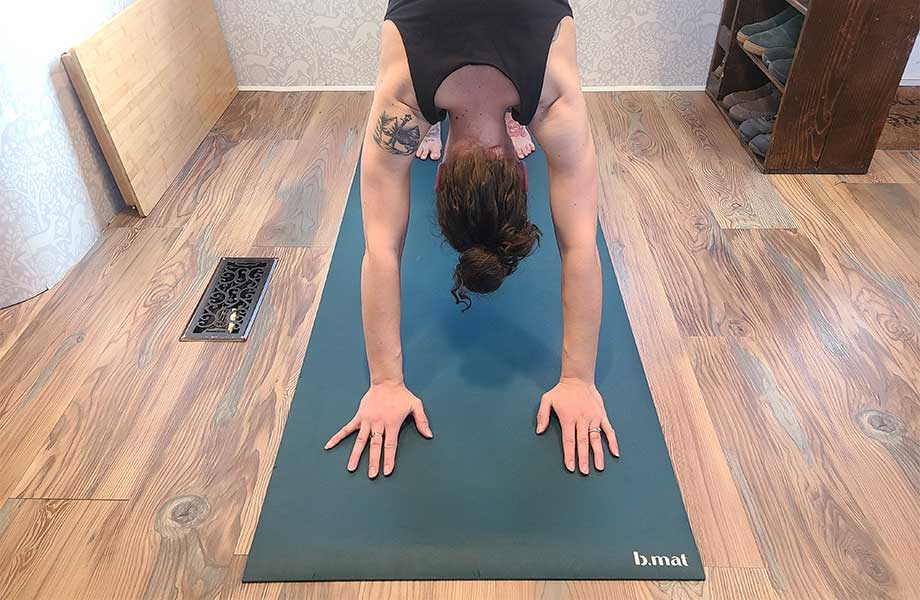We test and review fitness products based on an independent, multi-point methodology. If you use our links to purchase something, we may earn a commission. Read our disclosures.
A yoga session can be just what you need to center yourself before a busy day or to calm your mind and body after a stressful week. Whether you’re coming to your yoga mat to reconnect with your body, work up a sweat, or explore a new yoga flow, you’ll want to keep the space you practice—your mat—welcoming and clean. The last thing you want to think about when you press your forehead into the mat in child’s pose is, “Wait, when was the last time I cleaned this?”
As an experienced yoga teacher in hot yoga studios, I’ve smelled the funk that a 90-minute yoga class at 95 degrees can create and have seen perfectly good yoga mats ruined when just a moment’s care would have preserved the mat for years. How to clean a yoga mat—and how often you should clean it—depends a lot on how frequently you’re practicing, where you’re practicing, what type of yoga you’re practicing, and what kind of yoga mat you’re using.
RELATED: Yoga Poses
In this article, I’ll discuss several methods for cleaning your yoga mat—from homemade, non-chemical yoga mat sprays to pre-made spray cleaners to deep cleaning—so you can decide the best yoga mat cleaner and cleaning process for your needs.
Why You Should Clean Your Yoga Mat
Like every surface you come into contact with, your yoga mats get dirty! And just like you would wipe off a machine you use at the gym, wiping down your yoga mat after each use will keep it grime-free, clean, and ready to support your yoga practice. Cleaning your mat is both a way of practicing the mindfulness that yoga encourages and protecting your investment in a good yoga mat. Proper cleaning and care will make a yoga mat last for years, even with regular use.

Also, if you take yoga classes in a studio, your yoga mat comes into contact with all sorts of sweat and skin cells from other people around you. Everyone is carrying a different set of microbes—herpes simplex virus and Staphylococcus aureus1 (the bacteria that can cause staph infections) can be wandering around even the cleanest studios. So, regular cleaning and disinfecting is part of staying healthy as a yogi.
RELATED: 5 Best Exercise Mats
Options for Cleaning Your Yoga Mat
You can purchase a custom yoga mat cleaner or create a DIY mat cleaner using common household items. Here’s a breakdown of your options:
Spray and Wipe: Pre-Made Cleanser
You can find all kinds of pre-made mat sprays specifically designed for mat cleaning. Manduka, known for their yoga mats, makes one that’s a fine budget-friendly option if pre-made is your preference—though there are many other brands that also make them at different price points.
They’re easy to use and often come in a spray bottle. Simply spray your mat with the cleaning solution after your practice, and wipe down any excess liquid with a microfiber cloth. That said, this option can get pricey if you practice frequently, and it’s not a solution to disinfect or deep clean.
Spray and Wipe: Homemade and Chemical-Free
If you’re more of a DIY fitness enthusiast, you can make your own cleaning solution using household cleaning products in under a minute. To do this, just mix distilled white vinegar with three parts water in a spray bottle. Distilled white vinegar is antibacterial, so it will help kill most bacteria living on your mat post-workout. Several studies also suggest tea tree oil2 can be a natural antimicrobial, so adding a few drops of tea tree oil to your homemade solution is a great option. If you want something with a fresh scent, a tiny drop of lavender, eucalyptus, or other essential oil can be a lovely addition, but use them sparingly! Too much oil can turn your yoga mat’s surface slick.

Fitness Wipes
Plenty of companies make disposable fitness wipes for wiping down equipment, which is what a yoga mat is. Though it’s worth noting that while fitness wipes are convenient, you’ll want to double-check that the ingredients are free from harsh chemicals. Not only will chemicals like bleach or alcohol break down your mat’s material faster, but plenty of poses call for placing your face directly on your mat’s surface, and keeping your face away from harsh cleaning chemicals is a must.
RELATED: Down Dog App Review
Disinfectant: Homemade and Chemical-Free
Household dish soap is another excellent option for deep-cleaning and disinfecting your yoga mat. A little goes a very long way here, and there are a couple of options for how to go about this kind of deeper clean:
- Option 1: Mix some warm water (at least a gallon) in a large bowl with two to three drops of mild dish soap. Use a sponge or soft cloth to spot-clean your yoga mat with the soapy water and rinse thoroughly.
- Option 2: Fill a bathtub or large sink with warm water and a few drops of dish soap (again, use sparingly). Fully submerge your yoga mat for five to ten minutes, rinse, and let dry. Some mats aren’t meant to be underwater, so carefully read the care instructions on your mat. Be sure to let your mat air dry completely after your disinfecting session!
The Washing Machine
Washing machines are a great convenience, but think twice before giving your mat a machine wash, even on the gentle cycle! Many mats—particularly those with a grippy surface for hot yoga practices—can lose their efficacy if fully submerged in water. Washing machines, too, while convenient, are harsher on items than a microfiber cloth or a sponge. I don’t recommend using a washing machine to clean your mat, and I think everyone can agree it’s best to keep your yoga mat out of the dryer.
RELATED: Best Detergent for Sweaty Clothes
Routine vs Deep Cleaning
Generally speaking, aim to give your mat a once-over after each use. This can be as simple as wiping it down with a distilled vinegar cleaner or a fitness wipe.
It’s a good idea to deep clean and disinfect your mat once a month. You may want to do it twice a month if you’re regularly practicing in a studio or practicing hot yoga three times a week or more.
RELATED: Improve Your Fitness With The Best Mobility Exercises
How To Dry Your Yoga Mat
Drying your yoga mat is just as important as cleaning your yoga mat. I once destroyed a beautiful new yoga mat by cleansing it too thoroughly after a hot, humid practice and then rolling it up and sticking it in a corner for a week and a half. The next time I unrolled it, a spot of mold had sprung up and began to eat away at the non-slip material!

The best way to dry your yoga mat is to hang it up and let it air dry for at least thirty minutes—longer if it’s warm and/or humid. A regular clothes drying rack or railing will work well for this.
How To Clean a Yoga Mat: Final Thoughts
Whether you have a rubber mat or PVC mat or practice hot yoga or restorative, cleaning of your yoga mat should be considered a part of your regular yoga practice.
Luckily there are several convenient ways to disinfect your mat after each use, such as:
- Yoga mat sprays
- DIY cleaning solutions
- Fitness wipes
- Common household disinfectants or dishwashing soap
Yoga is about cleansing your mind and body, so a clean mat is a must-have.
How To Clean a Yoga Mat: FAQs
How often should yoga mats be washed?
It’s best to clean your yoga mat after each use, but that doesn’t mean you have to do a full scrub down and disinfect each time. Spraying your mat with a gentle cleanser and wiping it down with a clean cloth is sufficient.
Can you put your yoga mat in a washing machine?
You can, but that doesn’t mean you should! Washing machines are much harder on items than cleaning by hand, and it’s very likely to decrease the longevity of your mat. In certain circumstances, washing machines can even ruin your mat.
Can I use alcohol wipes to clean a yoga mat?
most often rubber, PVC, or TPE. Alcohol wipes are also likely to decrease the longevity of your mat dramatically, so I would recommend an alcohol-free fitness wipe instead.
Can I use vinegar and water to clean my yoga mat?
Vinegar is a great cleanser3. One part vinegar to three parts water in a spray bottle works wonders for regular mat cleaning. However, if you’re looking for a disinfectant, consider adding a drop or two of hydrogen peroxide.
How do you know when your yoga mat is worn out?
No yoga mat lasts forever, and depending on the type of mat you use, it may show different signs of wear. If you’re using a mat designed for hot yoga with a grippy surface, you may notice the surface becoming more slippery over time. If you use a more cushioned mat, that cushion can compress after regular use. You can also consider practicing with a yoga towel on top of your yoga mat to extend its longevity.
References
- Wang X, Zhang N, Glorieux S, Holtappels G, Vaneechoutte M, Krysko O, Zhang L, Han D, Nauwynck HJ, Bachert C. Herpes simplex virus type 1 infection facilitates invasion of Staphylococcus aureus into the nasal mucosa and nasal polyp tissue. PLoS One. 2012;7(6):e39875. doi: 10.1371/journal.pone.0039875. Epub 2012 Jun 29. PMID: 22768151; PMCID: PMC3387208.
- Carson, C. F., Hammer, K. A., & Riley, T. V. (2006). Melaleuca alternifolia (Tea Tree) oil: a review of antimicrobial and other medicinal properties. Clinical microbiology reviews, 19(1), 50–62. https://doi.org/10.1128/CMR.19.1.50-62.2006
- Zinn, M. K., & Bockmühl, D. (2020). Did granny know best? Evaluating the antibacterial, antifungal and antiviral efficacy of acetic acid for home care procedures. BMC microbiology, 20(1), 265. https://doi.org/10.1186/s12866-020-01948-8
Further reading

REP Fitness made a lot of upgrades to their cable attachment system; see if these updates are worth a look in this REP Ares 2.0 review. Read more

In our NOBULL apparel reviews, we cover our experience with some newer items from NOBULL in addition to some classic pieces. Read more

2008 CrossFit Games champ Jason Khalipa wants you to stop making these 10 home gym mistakes. Read more

A yoga session can be just what you need to center yourself before a busy day or to calm your mind and body after a stressful week. Whether you’re coming to your yoga mat to reconnect with your body, work up a sweat, or explore a new yoga flow, you’ll want to keep the space you practice—your mat—welcoming and clean. The last thing you want to think about when you press your forehead into the mat in child’s pose is, » Read more about: How To Clean a Yoga Mat: Keep Your Practice Squeaky Clean! » Read more

